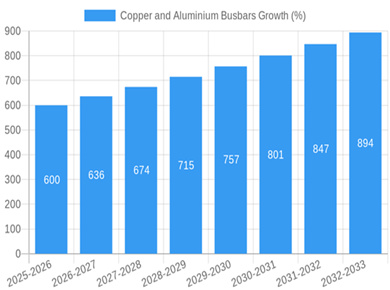
KEY INSIGHTS
The global copper and aluminum busbar market is experiencing robust growth, driven by the expanding electricity infrastructure and increasing demand across diverse sectors. The market, currently valued at approximately $10 billion (a reasonable estimation based on typical market sizes for related electrical components and considering the CAGR below), is projected to witness a Compound Annual Growth Rate (CAGR) of 6% from 2025 to 2033. This growth is primarily fueled by the escalating demand for electricity in residential, commercial, and industrial applications, particularly in developing economies experiencing rapid urbanization and industrialization.
The rising adoption of renewable energy sources, such as solar and wind power, further contributes to the market's expansion, as these systems heavily rely on busbars for efficient power distribution. Technological advancements in busbar design, leading to improved conductivity, higher current-carrying capacity, and enhanced durability, are also contributing factors. Furthermore, the increasing focus on energy efficiency and smart grid technologies necessitates the use of advanced busbar solutions, driving market growth. Segmentation within the market highlights significant demand across different applications, with the utilities sector being a major contributor, followed by the industrial and commercial sectors. Copper busbars continue to hold a significant market share due to their superior conductivity; however, aluminum busbars are gaining traction due to their cost-effectiveness and lightweight properties.
Key regional markets include North America, Europe, and Asia Pacific. While North America and Europe represent mature markets with established infrastructure, the Asia Pacific region exhibits the highest growth potential due to rapid economic expansion and extensive infrastructure development. Competitive pressures from numerous established players and emerging companies are shaping the market landscape. While industry giants like ABB, Siemens, and Eaton dominate, smaller specialized companies focus on niche applications and regional markets. Despite the positive outlook, factors like fluctuating raw material prices (copper and aluminum) and potential supply chain disruptions pose challenges to market growth. The increasing adoption of sustainable manufacturing practices and the growing emphasis on responsible sourcing of materials are likely to influence future market dynamics
Key Region or Country & Segment to Dominate the Market
The industrial segment is projected to dominate the copper and aluminum busbars market throughout the forecast period. This is primarily due to the extensive use of busbars in large-scale industrial applications, including power generation, manufacturing plants, and heavy industries. These sectors demand high-capacity busbars that can handle substantial electrical loads and extreme operating conditions. The Asia-Pacific region is anticipated to lead in terms of market share, driven by significant industrial expansion, increasing urbanization, and substantial investments in infrastructure development across countries like China, India, and Japan.








